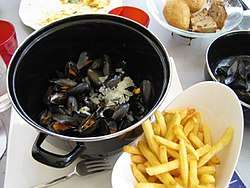Moules-frites
Moules-frites or moules et frites[1] (French pronunciation: [mul.fʁit]]; Dutch: mosselen-friet) is a main dish of mussels and fries originating in Belgium.[2] The title of the dish is French, moules meaning mussels and frites fries, with the Dutch name for the dish meaning the same. It is considered the national dish of Belgium.[3]
 Moules, served in the pan, with fries. | |
| Alternative names | Mosselen-friet (in Dutch) |
|---|---|
| Course | Main course |
| Place of origin | Belgium |
| Serving temperature | Hot |
| Main ingredients | Potatoes, Mussels |
Background
Although moules-frites are popular in many countries, it is thought that the dish originated in Belgium.[4] It is likely that it was originally created by combining mussels, a popular and cheap foodstuff eaten around the Flemish coast, and fried potatoes which were commonly eaten around the country in winter when no fish or other food was available.[4]
In both Belgium and France, moules-frites are available in most restaurants. According to a survey conducted by TNS, moules-frites was identified as the second favourite dish in France, receiving a vote of 20 percent, narrowly losing to magret de canard which received 21 percent.[5]
On average, between 25 and 30 tonnes of moules are consumed each year in Belgium as moules-frites.[6] Much of the mussels consumed in Belgium come from mussel farms in nearby Zeeland in the Netherlands.[7]
Variants and preparation
Moules
The ways in which the mussels are cooked in the dish can vary significantly. Some common variants include:
- Moules marinière: Probably the most common and internationally recognisable recipe,[8] Moules marinière includes white wine, shallots, parsley and butter.[9]
- Moules natures: The mussels are steamed with celery, leeks and butter.[2]
- Moules à la crème: Another common recipe, thickened with flour and cream.[2]
- Moules parquées: A dish, probably originating in Brussels, of raw mussels on the half-shell, served with a lemon-mustard-sauce.
- Moules à la bière: Mussels cooked in sauce containing beer instead of white wine.[10]
- Moules à l'ail: Mussels cooked with sliced or minced garlic.[2]
Less commonly, fusion variants are seen in which the stock may be flavoured with non-local ingredients such as Espelette pepper or Pernod liquor.[2] They can also be served with "Mosselsaus", a sauce that is made with mayonnaise, mustard and vinegar.
Frites
In various forms, frites or friet play an important role in Belgian culture and cuisine. Within Belgium, bintje potatoes are generally preferred as a basis to make fries because of their high starch content.[11][2] They are generally double-fried (fried, left to cool and then fried again) in order to make them both moist in the core and crispy on the outside.[11]
Presentation
As a dish, the moules and the frites are usually served separately, to avoid the fries becoming soggy in the sauce. Often, the moules are served in the pan used to cook them.[12] A second dish is generally provided for the discarded mussel shells.
See also
References
- Spoiden 2001, p. 162.
- Malgieri 2011.
- Spoiden 2001, p. 169.
- ifood.tv.
- Les News Nutrition 2011.
- Coenart 2011.
- Spoiden 2001, p. 168.
- Milano 2016.
- Thompson.
- Where the Food Is 2012.
- Spoiden 2001, p. 166.
- Spoiden 2001, p. 159.
Bibliography
- Coenart, Virginie (14 July 2011). "A nous les moules-frites!". RTL. Retrieved 13 August 2014.
- "Moules Frites". ifood.tv. Archived from the original on 2 May 2016. Retrieved 21 March 2020.
- "Le magret de canard, plat préféré des Français, devant les moules-frites". Les News Nutrition (in French). Doctissimo. 25 October 2011. Archived from the original on 3 January 2012. Retrieved 2 December 2012.
- Malgieri, Nick (18 May 2011). "A National Obsession: Belgium's Moules Frites". Saveur. Retrieved 13 November 2012.
- Milano, Pamela (17 October 2016). "How Did Mussels Become A Belgian Specialty?". Culture Trip. Archived from the original on 21 March 2020. Retrieved 21 March 2020.
- Spoiden, Stéphane (2001). "The Betrayal of Moules-frites". In Schehr, Lawrence R.; Weiss, Allen S. (eds.). French Food: On the Table, On the Page, and in French Culture. New York: Routledge. ISBN 978-0415936286.
- Thompson, Antony Worrall. "Moules marinière". Food Recipes. BBC. Archived from the original on 14 March 2013. Retrieved 13 November 2012.
- "Belgium ❀ Moules frites". Where the Food Is. 22 January 2012. Retrieved 13 November 2012.
Further reading
- "Qui peut faire la peau à la "moules-frites"?". La Voix du Nord (in French). 5 September 2010. Archived from the original on 28 April 2014. Retrieved 13 November 2012.
External links
| Wikimedia Commons has media related to Moules-frites. |